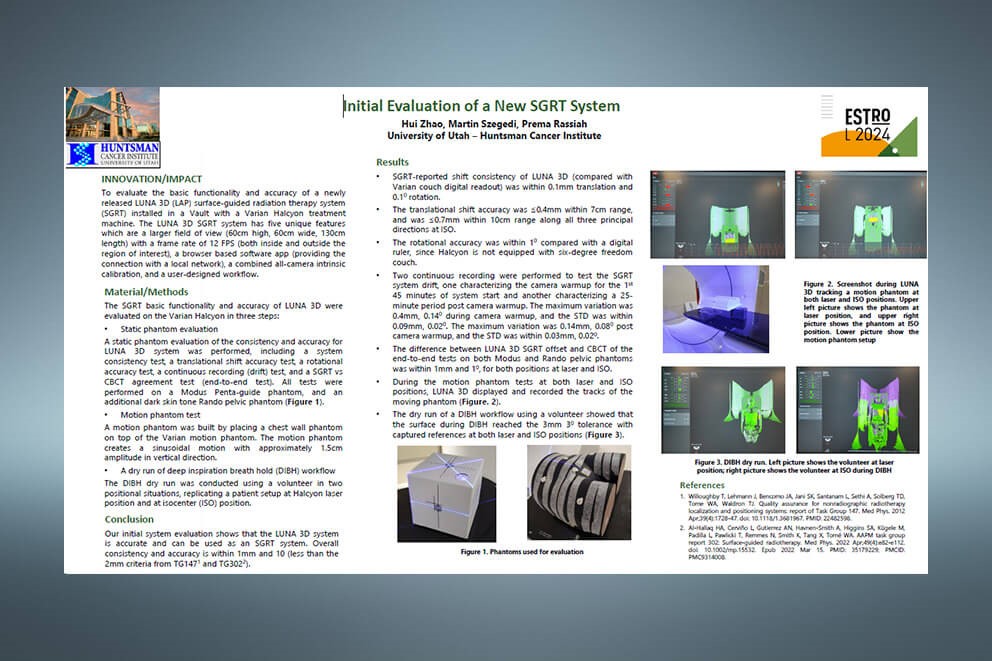Initial Evaluation of a New SGRT System
Initial Evaluation of a New SGRT System
“Our initial system evaluation shows that the LUNA 3D system is accurate and can be used as an SGRT system. Overall consistency and accuracy is within 1mm and 10 (less than the 2mm criteria from TG1471 and TG3022).”
Authors
Hui Zhao, Martin Szegedi, Prema Rassiah, University of Utah – Huntsman Cancer Institute
ESTRO 2024
INNOVATION/ IMPACT
To evaluate the basic functionality and accuracy of a newly released LUNA 3D (LAP) surface-guided radiation therapy system (SGRT) installed in a Vault with a Varian Halcyon treatment machine. The LUNA 3D SGRT system has five unique features which are a larger field of view (60cm high, 60cm wide, 130cm length) with a frame rate of 12 FPS (both inside and outside the region of interest), a browser based software app (providing the connection with a local network), a combined all-camera intrinsic calibration, and a user-designed workflow. Figure 1. Phantoms used for evaluation
Material/ Methods
The SGRT basic functionality and accuracy of LUNA 3D were evaluated on the Varian Halcyon in three steps:
- Static phantom evaluation A static phantom evaluation of the consistency and accuracy for LUNA 3D system was performed, including a system consistency test, a translational shift accuracy test, a rotational accuracy test, a continuous recording (drift) test, and a SGRT vs CBCT agreement test (end-to-end test). All tests were performed on a Modus Penta-guide phantom, and an additional dark skin tone Rando pelvic phantom.
- Motion phantom test A motion phantom was built by placing a chest wall phantom on top of the Varian motion phantom. The motion phantom creates a sinusoidal motion with approximately 1.5cm amplitude in vertical direction.
- A dry run of deep inspiration breath hold (DIBH) workflow The DIBH dry run was conducted using a volunteer in two positional situations, replicating a patient setup at Halcyon laser position and at isocenter (ISO) position.
Results
- SGRT-reported shift consistency of LUNA 3D (compared with Varian couch digital readout) was within 0.1mm translation and 0.10 rotation.
- The translational shift accuracy was ≤0.4mm within 7cm range, and was ≤0.7mm within 10cm range along all three principal directions at ISO.
- The rotational accuracy was within 10 compared with a digital ruler, since Halcyon is not equipped with six-degree freedom couch.
- Two continuous recording were performed to test the SGRT system drift, one characterizing the camera warmup for the 1st 45 minutes of system start and another characterizing a 25-minute period post camera warmup. The maximum variation was 0.4mm, 0.140 during camera warmup, and the STD was within 0.09mm, 0.020. The maximum variation was 0.14mm, 0.080 post camera warmup, and the STD was within 0.03mm, 0.020.
- The difference between LUNA 3D SGRT offset and CBCT of the end-to-end tests on both Modus and Rando pelvic phantoms was within 1mm and 10, for both positions at laser and ISO.
- During the motion phantom tests at both laser and ISO positions, LUNA 3D displayed and recorded the tracks of the moving phantom.
- The dry run of a DIBH workflow using a volunteer showed that the surface during DIBH reached the 3mm 30 tolerance with captured references at both laser and ISO positions.
Conclusion
Our initial system evaluation shows that the LUNA 3D system is accurate and can be used as an SGRT system. Overall consistency and accuracy is within 1mm and 10 (less than the 2mm criteria from TG1471 and TG3022).

